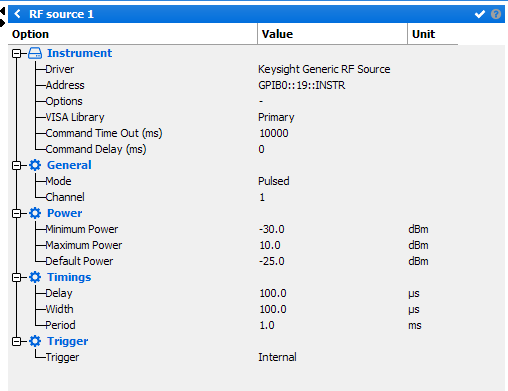RF Source
Usually, the RF Source is often integrated in the Vector Network Analyzer (VNA), however there are some cases where an
external source needs to be used (Modulated signal, 2-Tones or Pulsed characterization).

Note: "Internal RF source of the VNA", "Src1" or "Src2" can be combined with an
external power combiner generate a 2-tone signal.

When clicking on the “Src1” picture in the setup editor, the following menu appears on
the right side of the schematic:


Instrument
- Driver: select the appropriate driver corresponding to the instrument (refer to Supported RF Sources list)
- Address: set the communication address. Note the
 icon can be use to open the Instrument Scanner
icon can be use to open the Instrument Scanner - Options: set the specific driver options clicking on
 icon (refer to Supported Instruments section)
icon (refer to Supported Instruments section) - VISA Library: set the VISA Library (*.dll) used to communicate with the instrument (see help on this page: Getting Started : "Configure the VISA Library on the control PC")
- Command Time Out (ms): elapsed time before returning an error message if no response from instrument
- Command Delay (ms): delay before sending a command
General
- Mode: choose the signal mode (CW or Pulsed)
- Channel: select the RF output channel used
Power
- Minimum Power: set the minimum raw RF power adjustable by IQSTAR
- Maximum Power: set the maximum raw RF power adjustable by IQSTAR
- Default Power: set the default raw RF power when the RF source is turned ON. This value is also the initial raw power value applied during an optimization process
Timings (available only in Pulsed mode)
- Delay: set the pulse delay.
- Width: set the pulse width.
- Period: set the pulse period.
Note: These timings can be re-adjusted in the 'Chronograms' tab.
Trigger (available only in Pulsed mode)
Select the Internal or External Positive/Negative Edge Trigger. The internal trigger signal comes from the RF source, whereas an external comes from another instrument such the VNA.
